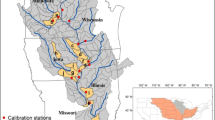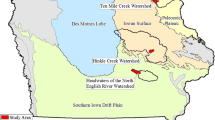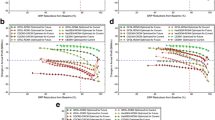Abstract
Agricultural production is a major source of nonpoint source pollution contributing 44% of total nitrogen (N) discharged to the Chesapeake Bay. The United States Environmental Protection Agency (US EPA) established the Total Maximum Daily Load (TMDL) program to control this problem. For the Chesapeake Bay watershed, the TMDL program requires that nitrogen loadings be reduced by 25% by 2025. Climate change may affect the cost of achieving such reductions. Thus, it is necessary to develop cost-effective strategies to meet water quality goals under climate change. We investigate landscape targeting of best management practices (BMPs) based on topographic index (TI) to determine how targeting would affect costs of meeting N loading goals for Mahantango watershed, PA. We use the results from two climate models, CRCM and WRFG, and the mean of the ensemble of seven climate models (Ensemble Mean) to estimate expected climate changes and the Soil and Water Assessment Tool-Variable Source Area (SWAT-VSA) model to predict crop yields and N export. Costs of targeting and uniform placement of BMPs across the entire study area (423 ha) were compared under historical and future climate scenarios. Targeting BMP placement based on TI classes reduces costs for achieving water quality goals relative to uniform placement strategies under historical and future conditions. Compared with uniform placement, targeting methods reduce costs by 30, 34, and 27% under historical climate as estimated by the Ensemble Mean, CRCM and WRFG, respectively, and by 37, 43, and 33% under the corresponding estimates of future climate scenarios.








Similar content being viewed by others
Notes
Results of this study are based on the assumption of the farm profit maximization. In some cases actual crop and BMP choices observed in the watershed may deviate from those predicted by profit maximization.
References
Arnold JG, Moriasi DN, Gassman PW, Abbaspour KC, White MJ, Srinivasan R, Santhi C, Harmel RD, van Griensven A, Van Liew MW, Kannan N, Jha MK (2012) SWAT: Model use, calibration, and validation. Transactions of the ASABE 55(4):1491–1508
Azzaino Z, Conrad JM, Ferraro PJ (2002) Optimizing the riparian buffer: Harold Brook in the Skaneateles Lake Watershed, New York. Land Econ 78(4):501–514
Bosch DJ et al. (2018) Meeting water quality goals under climate change in Chesapeake Bay watershed, USA. Journal of the American Water Resources Association 54(6):1239–1257
Bryant RB et al. (2011) US Department of Agriculture Agricultural Research Service Mahantango Creek Watershed, Pennsylvania, United States: Physiography and history. Water Resour Res 47(8):1–5. https://doi.org/10.1029/2010WR010056
Chesapeake Bay Foundation (2015) Best management practices. http://www.cbf.org/about-the-bay/issues/agriculture/best-management-practices
Chesapeake Bay Program (2015) Chesapeake Statistics, United States Environmental Protection Agency. https://stat.chesapeakebay.net/?q=node/130&quicktabs_10=1. Accessed Apr 2015
Collick AS et al. (2015) Predicting phosphorus dynamics in complex terrains using a variable source area hydrology model. Hydrol Process 29(4):588–601
Cools J et al. (2011) Coupling a hydrological water quality model and an economic optimization model to set up a cost-effective emission reduction scenario for nitrogen. Environ Model & Softw 26(1):44–51
Cooper SR (1995) Chesapeake Bay watershed historical land use: impact on water quality and diatom communities. Ecol Appl 5(3):703–723
Devereux OH, Rigelman JR (2014) CAST: An Online Tool for facilitating local involvement in watershed implementation plans for the Chesapeake Bay Total Maximum Daily Load. Journal of Water Management Modeling. https://www.chijournal.org/C364. https://doi.org/10.14796/JWMM.C364
Dillaha TA, Simpson TW, Weammert SE (2009) Offstream watering with fencing and offstream watering without fencing practices. Final Report December 2009, p 414
Easton ZM et al. (2008) Re-conceptualizing the soil and water assessment tool (SWAT) model to predict runoff from variable source areas. J Hydrol 348(3):279–291
FAO (2007) State of the World’s Forests 2007. Food & Agriculture Org
GAMS Development Corporation (2018) User’s Guide. GAMS Development Corporation, Washington D.C. https://www.gams.com/latest/docs/UG_MAIN.html
Giri S, Nejadhashemi AP, Woznicki SA (2012) Evaluation of targeting methods for implementation of best management practices in the Saginaw River Watershed. J. Environ. Manag. 103:24–40
Giri S et al. (2014) Analysis of best management practice effectiveness and spatiotemporal variability based on different targeting strategies. Hydrol Process 28(3):431–445
Jeppesen E et al. (2011) Climate change effects on nitrogen loading from cultivated catchments in Europe: implications for nitrogen retention, ecological state of lakes and adaptation. Hydrobiologia 663(1):1–21
Jha MK et al. (2010) Targeting land-use change for nitrate-nitrogen load reductions in an agricultural watershed. J Soil Water Conserv 65(6):342–352
Khanna M, Yang W, Farnsworth R, Önal H (2003) Cost-effective targeting of land retirement to improve water quality with endogenous sediment deposition coefficients. Am J Agric Econ 85(3):538–553
Kosten S et al. (2012) Warmer climates boost cyanobacterial dominance in shallow lakes. Glob Change Biol 18(1):118–126
McCarl BA, Spreen TH (1997) Applied Mathematical Programming Using Algebraic Systems.. Texas A&M, College Station, Texas. http://agecon2.tamu.edu/people/faculty/mccarl-bruce/mccspr/thebook.pdf, Accessed 12 Feb 2018
Mearns LO et al. (2009) A regional climate change assessment program for North America. EOS, Trans Am Geophys Union 90(36):311–311
Nakicenovic N et al. (2000) Special report on emissions scenarios (SRES), a special report of Working Group III of the intergovernmental panel on climate change. Cambridge, UK. Cambridge University Press
Nutrient Management Expert Panel (2015) Nutrient management: Recommendations for approval by the Water Quality Goal Implementation Team’s Watershed Technical and Agricultural Workgroups. Phase 5.3.2. Chesapeake Bay Program, Annapolis, Maryland
Penn State (2015) The Agronomy Guide 2015–2016. College of Agricultural Science. State College, Pennsylvania
Rao NS et al. (2009) Modeling watershed-scale effectiveness of agricultural best management practices to reduce phosphorus loading. J Environ Manag 90(3):1385–1395
Rhodes JL et al. (2011) Broiler production management for potential and existing growers. University of Maryland Extension Bulletin, College Park, Maryland. >https://extension.umd.edu//sites/extension.umd.edu/files/_docs/POULTRY_BroilerProductionManagement_final1.pdf
Ritter WF, Scarborough RW, Chirnside AEM (1998) Winter cover crops as a best management practice for reducing nitrogen leaching. J Contam Hydrol 34(1):1–15
Rummukainen M (2010) State-of-the-art with regional climate models. Wiley Interdiscip Rev: Clim Change 1(1):82–96. https://doi.org/10.1002/wcc.8
Stubbs M (2014) Conservation Reserve Program (CRP): Status and issues. Congressional Research Service Report, 42783, 24p
United States Department of Agriculture (USDA) (2015) Crop progress and condition. National Agricultural Statistics Service, Northeastern Regional Field Office. http://www.nass.usda.gov/Statistics_by_State/Pennsylvania/Publications/Crop_Progress_and_Condition/
United States Department of Agriculture (USDA) (2016) Conservation reserve program monthly summary - November 2016. https://www.fsa.usda.gov/Assets/USDA-FSA-Public/usdafiles/Conservation/PDF/NOV2016%20CRP%20Summary.pdf
United States Environmental Protection Agency (USEPA) (2010a) Chesapeake Bay Total Maximum Daily Load (TMDL) Fact Sheet. Washington, DC. USEPA. http://www.epa.gov/reg3wapd/pdf/pdf_chesbay/BayTMDLFactSheet8_26_13.pdf. Accessed 1 July 2016
United States Environmental Protection Agency (USEPA) (2010b) Chesapeake Bay Total Maximum Daily Load for nitrogen, phosphorus, and sediment. USEPA Region III. Philadelphia, PA. Phase 1 document: Commonwealth of Virginia Chesapeake Bay TMDL Phase I Watershed Implementation Plan Revision of the Chesapeake Bay Nutrient and Sediment Reduction Tributary Strategy November 29. USEPA
Van Houtven G et al. (2012) Nutrient credit trading for the Chesapeake Bay: An economic study. RTI International, Research Triangle Park, NC
Wagena MB et al. (2018) Impact of climate change and climate anomalies on hydrologic and biogeochemical processes in an agricultural catchment of the Chesapeake Bay watershed, USA. Sci Total Environ 637:1443–1454
Wagena MB, Easton ZM (2018) Agricultural conservation practices can help mitigate the impact of climate change. Sci Total Environ 635:132–143
Walthall CL et al. (2013) Climate change and agriculture in the United States: Effects and adaptation. USDA Technical Bulletin 1935, Washington DC, p 186
Willis DB, Privette C (2017) A cost effective modeling approach for targeting the location of best management practices within a rapidly growing urban watershed to achieve regional water quality standards. In 2017 Annual Meeting, 4–7 February 2017, Mobile, Alabama (No. 252820). Southern Agricultural Economics Association
Wu J et al. (2006) A water quality based approach for watershed wide BMP strategies. J Am Water Resour Assoc 42(5):1193–1204
Yang W, Weersink A (2004) Cost-effective targeting of riparian buffers. Can J Agric Econ/Rev Can d’agroeconomie 52(1):17–34
Yang W et al. (2005) Spatial targeting of conservation tillage to improve water quality and carbon retention benefits. Can J Agric Econ/Rev Can d’agroeconomie 53(4):477–500
Yang W, Liu W, Liu Y, Corry RC, Kreutzwiser RD (2014) Cost-effective targeting ofriparian buffers to achieve water quality and wildlife habitat benefits. International Journal of River Basin Management 12(1):43–55
Acknowledgements
This work was supported by the National Science Foundation, Water, Sustainability, and Climate program [grant number CBET-1360280] and by the United States Department of Agriculture, National Institute of Food and Agriculture, Hatch project VA-135911, accession number 227572. The authors express appreciation to Ray Najjar and Andrew Ross for assistance in generating climate data.
Author information
Authors and Affiliations
Corresponding author
Additional information
Publisher’s note: Springer Nature remains neutral with regard to jurisdictional claims in published maps and institutional affiliations.
Supplementary information
Rights and permissions
About this article
Cite this article
Xu, Y., Bosch, D.J., Wagena, M.B. et al. Meeting Water Quality Goals by Spatial Targeting of Best Management Practices under Climate Change. Environmental Management 63, 173–184 (2019). https://doi.org/10.1007/s00267-018-01133-8
Received:
Accepted:
Published:
Issue Date:
DOI: https://doi.org/10.1007/s00267-018-01133-8




